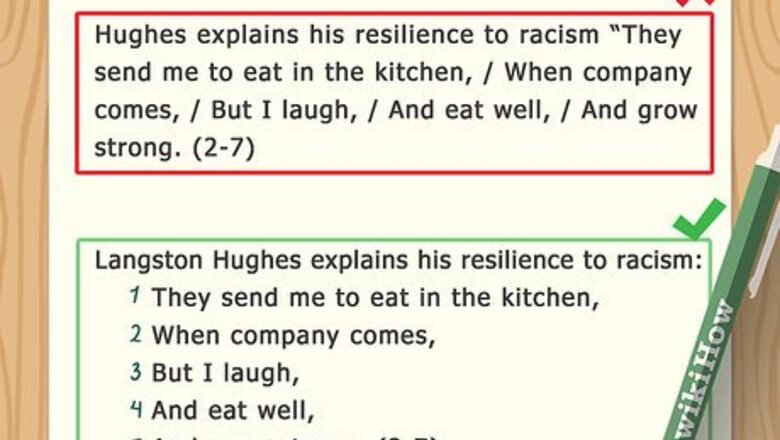
views
Forming a Block Quote in MLA
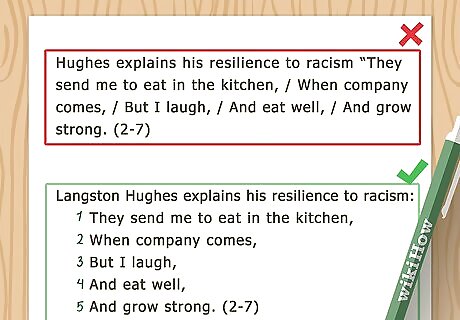
Use a block quote for quotations longer than 3 to 4 lines. When using MLA format, a block quote should be used if the material you are quoting is longer than 3 lines of verse, such as in a poem. Use a block quote if the text is longer than 4 lines of prose, such as in a novel. For example, if you are quoting the first stanza from Robert Frost’s “The Road Not Taken,” you should use a block quote, because it is longer than 3 lines. Another example might be if you are quoting a paragraph from Great Expectations by Charles Dickens. If the paragraph is more than 4 lines, use a block quote.
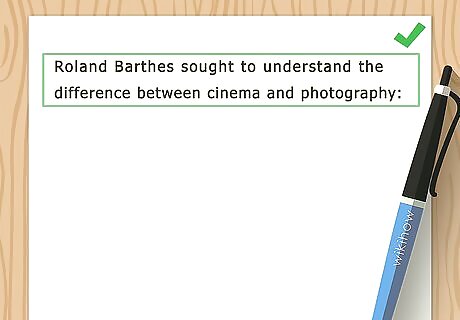
Introduce the quote with a short sentence. Place a colon or a comma at the end of the sentence that leads up to the block quote, depending on what’s appropriate. Use a colon when the quote is a continuation of your thought. Use a comma to show what the author said. For example, you might write: "Roland Barthes sought to understand the difference between cinema and photography:" "In his novel White Jacket, Herman Melville argues,"
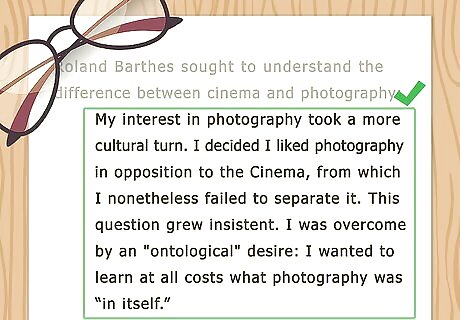
Add the quote on a new line without quotation marks. Unlike short quotations in MLA, block quotes do not need any quotation marks. You will need to start the quote on a separate line. Press enter to create a new paragraph for your quote. For example, your quote might look like: Roland Barthes sought to understand the difference between cinema and photography:My interest in photography took a more cultural turn. I decided I liked photography in opposition to the Cinema, from which I nonetheless failed to separate it. This question grew insistent. I was overcome by an "ontological" desire: I wanted to learn at all costs what photography was "in itself."

Indent the quote ⁄2 inch (1.3 cm) from the left margin. The entire quote should be indented so that it looks like a “block” of text separate from the rest of the paragraph. To do this, highlight the whole quote and press the “Tab” button on your keyboard. You can also move the tabs on the ruler above your word document ⁄2 inch (1.3 cm) to the right. If you are quoting more than one paragraph, indent the first line of each paragraph another ⁄4 inch (0.64 cm).

Keep the quote double-spaced. MLA format calls for double-spacing throughout the main body of the paper. Keep this spacing for the block quote. If you’re citing more than 3 lines of poetry, keep the original line breaks and formatting. For example, See fox jump; over the hill. Unlike the dipping sun; setting slowly still. (Pool 2)

Add the author and page number in parentheses at the end of the quote. Put your citation after the closing punctuation of the last sentence. Do not write a "p." or any other abbreviation before the page number. For example, your citation might look like: "I was overcome by an "ontological" desire: I wanted to learn at all costs what photography was "in itself." (Barthes 3)"
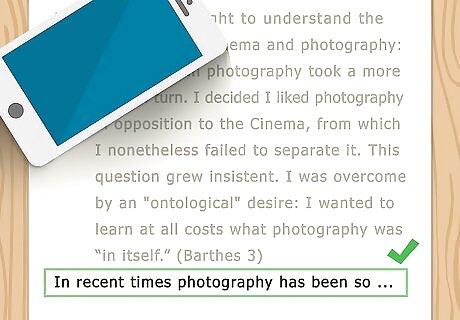
Continue your own writing on a new line. Once you have finished the block quote, press enter to start a new line. If you are continuing in the same paragraph, remove the indentations and keep your normal margins. If you are starting a new paragraph, indent the first line of that paragraph by ⁄2 inch (1.3 cm).
Making a Block Quote in APA
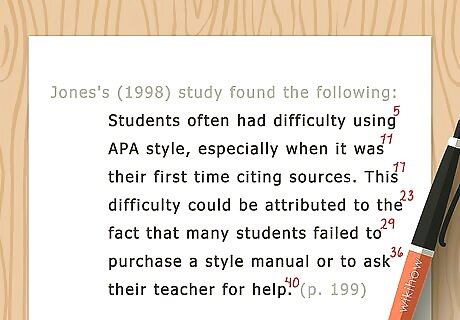
Use block quotes for quotations that are 40 words or longer. APA style dictates that you use a block quote based on the number of words. Count the words in your quote to determine if it has more than 40. If so, use a block quote. On a word processor like Microsoft Word, you can highlight the quote and click “Word Count” under “Review” or “Proofing.” This will tell you how many words are in the quote. For example, if you are quoting a long paragraph from the Diagnostic and Statistical Manual of Mental Disorders, you should use a block quote.
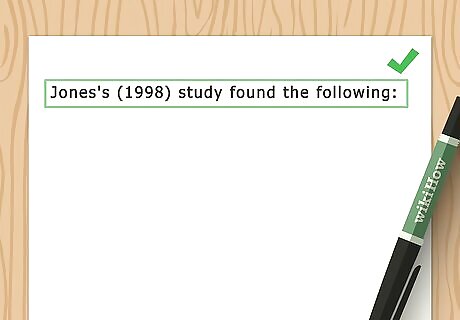
Introduce the quote with a signal phrase. The signal phrase is a sentence that tells your reader that you are about to cite a quote. Put a comma or a colon at the end of this phrase. There are 3 common ways to introduce a block quote in APA style. You can: State the author and the year in the text at the beginning of the sentence. For example, you might write, In Morgan’s 2013 study, he stated, Name only the author in the text at the beginning of the sentence. In this case, you must put the year in parentheses next to the author’s name. For example, Morgan (2013) found that: Avoid naming the author at the beginning of the sentence. For example, you might say, Some studies disagreed with these findings:

Indent the quote ⁄2 inch (1.3 cm) from the left margin. Start the quote on a new line. Highlight the quote and press tab once. Alternatively, move the tabs on the ruler above the document over ⁄2 inch (1.3 cm). The entire quote must be indented. You do not need to use quotation marks for the quote. If you are citing multiple paragraphs, indent the first line of the quotation by an additional ⁄2 inch (1.3 cm).

Make the quote double-spaced. In APA style, your entire paper should be double-spaced, including your block-quotes. To double-space the quote, highlight the quote. Click on the paragraph formatting button, and choose “double” or “2.0” line spacing.

Put the citation in parentheses at the end of the quote. Depending on how you introduced the quote, you may need to put the author, year, and page number of the quote. Separate these by commas, and put a "p." before the page number. Put this citation after the closing punctuation of the last sentence in the quote. If you named the author and the year in the signal phrase, you only need to include the page number at the end. For example, In Jones’ 1998 study, he found that:The scent of lavender reduced stress by 20%. Individuals who were exposed had lower heart rates and blood pressure compared to the control group. Lavender also decreased the amount of time it took for subjects to fall asleep in clinical studies. (p. 112) Jones (1998) found that:The scent of lavender reduced stress by 20%. Individuals who were exposed had lower heart rates and blood pressure compared to the control group. Lavender also decreased the amount of time it took for subjects to fall asleep in clinical studies. (p. 112) If you did not name the author and the year at the beginning of the sentence, you need to include the author, year, and page number in the parentheses at the end. For example, One study found that:The scent of lavender reduced stress by 20%. Individuals who were exposed had lower heart rates and blood pressure compared to the control group. Lavender also decreased the amount of time it took for subjects to fall asleep in clinical studies. (Jones, 1998, p. 112)

Return to normal margins once the quote is finished. Press enter to start a new line. If you want to keep writing in the same paragraph, make the quote flush left by removing the extra indentation. If you are starting a new paragraph, indent the first line of that paragraph by ⁄2 inch (1.3 cm).
Forming a Block Quote in Chicago Style

Use a block quote for text longer than 5 lines or 100 words. This rule is generally used for prose. If you are quoting poetry, block the quote if it is more than 2 lines. For example, if you are quoting a 7 line paragraph from Charlotte Brontë’s Jane Eyre, you should use a block quote.

Introduce the quote with a signal phrase. This sentence might state who said the quote or provide an argument for why the quote is important. End the quote with either a colon or comma. Use a colon if the quote proves or continues your thought. For example, you might write: In many ways, the text creates a distinction between the seen and unseen: Use a comma if the quote is simply used to show what the writer said. For example, In response, Jones said,

Start the block quote on a new line without quotation marks. After you’ve introduced your quote, begin the quote on a new line. This sets the quote apart from the other text.

Indent the quote by ⁄2 inch (1.3 cm) from the left margin. For most computers and writing applications, you can achieve this indent by highlighting the quote and hitting the “tab” button. You can also slide the tabs on the ruler ⁄2 inch (1.3 cm) to the right.

Make the quote single-spaced. Even if the rest of the paper is double-spaced, the quote should be single spaced. Highlight the quote. Go to paragraph formatting on your word processor and click "single" or "1.0" spacing. If you are citing multiple paragraphs, indent the first line of the quotation by an additional ¼ inch (0.64 cm). Indent the first line of each successive paragraph the same way.

Add a footnote or parenthetical citation to the end. Place the footnote or parenthetical citation after the closing punctuation of the last sentence of the quote. The first footnote should contain the author’s name, title of the work, location of publication, publisher, and date, in that order. For example, Peterson, Mary. Effects of Smoking on the Body. Cambridge, MA: Harvard University Press, 1984. A parenthetical citation is after the last punctuation mark of the block quote and might look like this: (Peterson, 118)

Start a new line to continue writing your paper. When the quote ends, start a new line to keep writing your paper. If the same paragraph continues, remove the extra indentation to return to your normal margins. If you are starting a new paragraph, indent the first line of that paragraph by ⁄2 inch (1.3 cm).


















Comments
0 comment